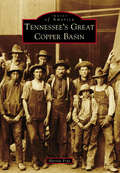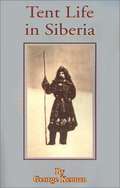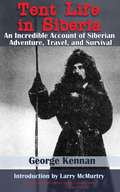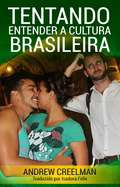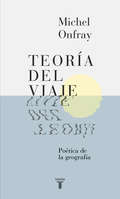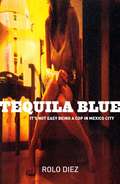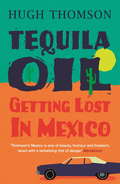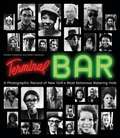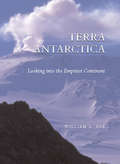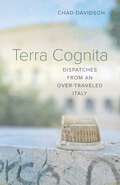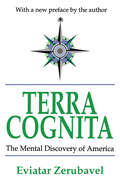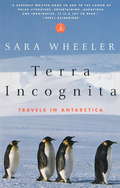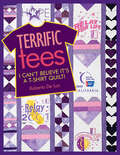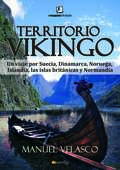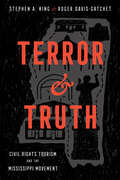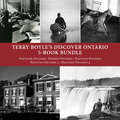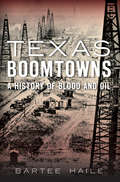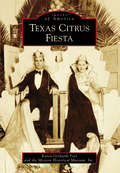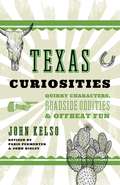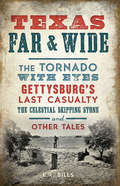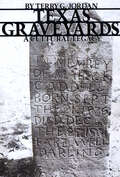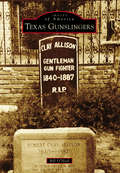- Table View
- List View
Tennessee’s Great Copper Basin (Images of America)
by Harriet FryeIn 1843, the discovery of copper in Tennessee’s far southeastern corner sparked a transformation in the isolated area known to geologists as the Ducktown Basin. By 1854, the first shafts had been sunk, and 28 mining companies had been incorporated for the purpose of exploring the possible wealth of the Ducktown district. For generations to come, the families of mine captains from Cornwall, executives and engineers from the industrial North, emigrants from Europe and the Middle East, miners drawn by the promise of jobs, and farmers who had bought land for pennies an acre in the 1830s would sit side by side in the same small churches and send their children to the same small schools. In the process, they would create a kind of culture that few small Southern communities had ever seen. This book, illustrated with photographs gathered from the scrapbooks and attics of their descendants, tells their story.
Tent Life in Siberia
by George F. KennanFirst published in 1870, this book is a thrilling account by telegraph operator George Kennan, who signed on to build a telegraph line across Siberia in the 1860s. Though the Trans-Siberian telegraph line failed, we are left today with this tale of virtual first contact with a land and a people.
Tent Life in Siberia: An Incredible Account of Siberian Adventure, Travel, and Survival
by Larry Mcmurtry George KennanThis collection chronicles the fiction and non fiction classics by the greatest writers the world has ever known. The inclusion of both popular as well as overlooked pieces is pivotal to providing a broad and representative collection of classic works.
Tentando Entender a Cultura Brasileira
by Andrew CreelmanUm britânico, tentando entender a cultura brasileira... com diversos resultados! É uma verdade admitida por praticamente todo cara de dezessete anos com internet: o Brasil é um dos países mais sexy do planeta. Quando você olha fotos online do país, você espera por deusas do samba, praias ridiculamente tropicais e, claro, o Carnaval. Mas se você já se perguntou como é a vida além dessas imagens, este livro é para você. Redigido pelo renomado blogueiro britânico Andrew Creelman, essas memórias vão te dar uma visão íntima de dentro da realidade da cultura brasileira. Depois de ter chegado no país meio do nada, Andrew passou os últimos quatro anos em São Paulo tentando entender os brasileiros e sua cultura. No livro, alguns questões de levantar as sobrancelhas são exploradas. Será que o Brasil se parece com um enorme e perigoso Grand Theft Auto? Como é viver no país louco por futebol? Todas as mulheres brasileiras são maravilhosas? Como é dar aulas aqui? E talvez a pergunta mais importante explorada nessas páginas: por que, ah, por que os brasileiros usam tão pouca roupa na praia?!? Um britânico, tentando entender a cultura brasileira... com resultados variados! É uma verdade admitida por praticamente todo cara de dezessete anos com internet: o Brasil é um dos países mais sexy do planeta. Quando você olha fotos online do país, você espera por deusas do samba, praias ridiculamente tropicais e, claro, o Carnaval. Mas se você já se perguntou como é a vida além dessas imagens, este livro é para você. Redigido pelo renomado blogueiro britânico Andrew Creelman, essas memórias vão te dar uma visão íntima de dentro da realidade da cultura brasileira. Depois de ter chegado no país meio do nada, Andrew passou os últimos quatro anos em São Paulo tentando entender os brasileiros e sua cultura. No livro, alguns questões de levantar as sobrancelhas são exploradas. Será que o Brasil se parece
Teoría del viaje
by Michel OnfrayUna guía para quienes quieran sentirse viajeros, y no turistas. Por Michel Onfray, autor de best-sellers comoTratado de ateología o Antimanual de filosofía. «Todo viaje es iniciático.» Michel Onfray convierte el viajar, uno de los sencillos placeres de la vida, en un estimulante tema de reflexión. Además de ser una invitación a soltar amarras, este libro tiene el poder de prolongar la emoción y el sabor del viaje a través de la filosofía y la literatura, de la historia y la mitología. Deseo de partir, preparativos sumidos en lecturas, elección del medio, entusiasmo y sorpresa a la llegada, despertar de los cinco sentidos durante la estancia, toma de notas y fotografías, regreso a casa, elaboración del recuerdo..., todas las etapas cobran en este libro una dimensión filosófica. Teoría del viaje es una declaración de guerra a nuestra tendencia a cuadricular y cronometrar nuestra existencia, y una brillante hoja de ruta para quienes quieran sentirse viajeros y no turistas. Reseña:«Onfray convierte el placer de viajar en un interesante tema de reflexión.»Gabi Martínez, Cultura/s, La Vanguardia «El profesor francés Michel Onfray ha escrito Teoría del viaje. Poética de la geografía, un manifiesto a favor del desajuste de todos los sentidos que supone "el deseo ferviente de la movilidad".»El Viajero de El País «El libro, este libro, constituye, todo él, una invitación no solo a la realización del viaje -cualquier viaje, ya sea en sentido real-físico, ya lo sea en sentido espiritual-,y tal tarea es algo que se presenta algo así como necesario complemento vital, como necesidad de manifestarse, de ser. En ese sentido otro aforismo vendría a ratificar lo expuesto, a sabiendas: "siempre se camina hacia el final, el que no existe".»Ricardo Martínez, Todo Literatura
Tequila Blue
by Nick Caistor Rolo Diez"Both a scathing and picaresque comedy, a biting and spicy concoction. Just like tequila."--Le MondeIt's not easy being a cop in Mexico City. Meet Carlito, a police detective with a complicated life. A wife, a mistress, children by both. He resorts to money laundering and arms dealing to finance his police activity. The money for justice must be found somewhere.The corpse in the hotel room is that of a gringo with a weakness for blue movies. Carlito's maverick investigation leads him into a labyrinth of gang wars and corrupt politicians.Rolo Diez, born in Argentina, was imprisoned for two years during the military dictatorship. He now lives in Mexico City, where he works as a novelist and screenwriter.
Tequila Oil: Getting Lost In Mexico
by Hugh Thomson'Try this tequila oil, Hugito. Just as the alcohol hits your stomach, the chilli will as well and blow it back into your brain. It will take your head off.' Explorer Hugh Thomson takes on Mexico.It's 1979, Hugh Thomson is eighteen, far from home, with time to kill - and on his way to Mexico. When a stranger tells him there's money to be made by driving a car over the US border to sell on the black market in Central America, Hugh decides to give it a go.Throwing himself on the mercy of Mexicans he meets or crashes into, Hugh and his Oldsmobile 98 journey through the region, meeting their fate in the slums of Belize City.Thirty years on, Hugh returns - older but not necessarily wiser - to complete his journey.
Tequila Oil: Getting Lost In Mexico
by Hugh Thomson'Try this tequila oil, Hugito. Just as the alcohol hits your stomach, the chilli will as well and blow it back into your brain. It will take your head off.' Explorer Hugh Thomson takes on Mexico.It's 1979, Hugh Thomson is eighteen, far from home, with time to kill - and on his way to Mexico. When a stranger tells him there's money to be made by driving a car over the US border to sell on the black market in Central America, Hugh decides to give it a go.Throwing himself on the mercy of Mexicans he meets or crashes into, Hugh and his Oldsmobile 98 journey through the region, meeting their fate in the slums of Belize City.Thirty years on, Hugh returns - older but not necessarily wiser - to complete his journey.
Terminal Bar
by Sheldon Nadelman Stefan NadelmanIn 1972 Shelly Nadelman began a ten-year run bartending at one of New York City's most notorious dives: the Terminal Bar, located across the street from the Port Authority Bus Terminal near Times Square. For ten years, right up until the bar closed for good in 1982, he shot thousands of black-and-white photographs, mostly portraits of his customers-- neighborhood regulars, drag queens, thrill-seeking tourists, pimps and prostitutes, midtown office workers dropping by before catching a bus home to the suburbs--all of whom found welcome and respite at the Terminal Bar. This extraordinary archive remained unseen for twenty years until his son Stefan rescued the collection, using parts of it in a documentary short. Featuring nine hundred photographs accompanied by reminiscences in Shelly Nadelman's inimitable voice, Terminal Bar brings back to life the 1970s presanitized Times Square, a raucous chapter of the city that never sleeps.
Terra Antarctica
by William FoxHow does the human mind transform space into place, or land into landscape? For more than three decades, William L. Fox has looked at empty landscapes and the role of the arts to investigate the way humans make sense of space. In Terra Antarctica, Fox continues this line of inquiry as he travels to the Antarctic, the "largest and most extreme desert on earth." This contemporary travel narrative interweaves artistic, cartographic, and scientific images with anecdotes from the author's three-month journey in the Antarctic to create an absorbing and readable narrative of the remote continent. Through its images, history, and firsthand experiences-snowmobile trips through whiteouts and his icy solo hikes past the edge of the mapped world-Fox brings to life a place that few have seen and offers us a look into both the nature of landscape and ourselves.
Terra Antarctica
by William FoxHow does the human mind transform space into place, or land into landscape? For more than three decades, William L. Fox has looked at empty landscapes and the role of the arts to investigate the way humans make sense of space. In Terra Antarctica, Fox continues this line of inquiry as he travels to the Antarctic, the "largest and most extreme desert on earth." This contemporary travel narrative interweaves artistic, cartographic, and scientific images with anecdotes from the author's three-month journey in the Antarctic to create an absorbing and readable narrative of the remote continent. Through its images, history, and firsthand experiences-snowmobile trips through whiteouts and his icy solo hikes past the edge of the mapped world-Fox brings to life a place that few have seen and offers us a look into both the nature of landscape and ourselves.
Terra Cognita: Dispatches from an Over-Traveled Italy
by Chad DavidsonTwenty-seven years in the making, Terra Cognita chronicles the author’s continual travels—and problematic (if still, at times, ecstatic) encounters—in the “bel paese.” Across nine richly evocative essays, Chad Davidson investigates the seemingly never-ending fascination that travelers have with Italy.As much a meditation on what home and away mean as it is a travel memoir, Terra Cognita finds literary predecessors such as Dante and Italo Calvino crowding in alongside more accustomed sights from travel shows, Hollywood films, and tourist guides. Though each essay departs from a particular location in Italy and remains rooted in the author’s own history there, the book ultimately becomes less about those places and more about the placelessness any such journey can engender, how—even after flying across an ocean and landing in a foreign country—we are still hopelessly and fully ourselves.
Terra Cognita: The Mental Discovery of America
by Eviatar ZerubavelMost of us are fascinated by the conventional storybook account of Christopher Columbus' heroic discovery of America in 1492. Yet, should the credit for discovering America go to a man who insisted it was but a few islands off the shores of China?In Terra Cognita, Eviatar Zerubavel argues that physical encounters are only one part of the complex, multifaceted process of discovery. Such encounters must be complemented by an understanding of the true identity of what is being discovered. The small group of islands claimed by Columbus to have been discovered off the shores of Asia was a far cry from what we now call America. The discovery of the New World was not achieved in a single day but was a slow process--mental as well as physical--that lasted almost three hundred years. By celebrating 1492 as a year of discovery, we inevitably distort the reality of history.In vividly documenting how a slowly emerging New World gradually forced itself into Europe's consciousness, Zerubavel shows that Columbus did not discover America on October 12, 1492. Supplemented by fascinating old maps and a new preface written for this paperback edition, Terra Cognita will be of interest to historians, geographers, cognitive scientists, sociologists, and students of culture.
Terra Incognita
by Sara WheelerIt is the coldest, windiest, driest place on earth, an icy desert of unearthly beauty and stubborn impenetrability. For centuries, Antarctica has captured the imagination of our greatest scientists and explorers, lingering in the spirit long after their return. Shackleton called it "the last great journey"; for Apsley Cherry-Garrard it was the worst journey in the world. This is a book about the call of the wild and the response of the spirit to a country that exists perhaps most vividly in the mind. Sara Wheeler spent seven months in Antarctica, living with its scientists and dreamers. No book is more true to the spirit of that continent--beguiling, enchanted and vast beyond the furthest reaches of our imagination. Chosen by Beryl Bainbridge and John Major as one of the best books of the year, recommended by the editors of Entertainment Weekly and the Chicago Tribune, one of the Seattle Times's top ten travel books of the year, Terra Incognita is a classic of polar literature.
Terrific Tees: I Can't Believe It's A T-shirt Quilt!
by Roberta De LuzGive new life to favorite T-shirts by making them into quilts you'll be proud to display or give.
Territorio Vikingo (El Viajero Intrépido)
by Manuel Velasco LagunaViaje por Suecia, Dinamarca, Noruega, Islandia y las Islas Británicas y descubre cómo vivían los vikingos a través de sus museos, restos arqueológicos, exposiciones, festivales y mercados. Coge tu mochila y prepárate para realizar un viaje alucinante al territorio que recorrieron los vikingos hace siglos de la mano de Manuel Velasco, incansable viajero que ha puesto rumbo al norte en numerosas ocasiones, para ver por sí mismo aquello que los libros cuentan y así poder dar su visión personal de los hechos. Partiendo de la isla de Gotland en Suecia, continuarás hasta Noruega, Dinamarca e Islandia, pasando por las Islas Británicas y terminando en Francia en una región que pasó a llamarse Normandía. Territorio Vikingo te ayudará a descubrir, gracias a su autor, este pueblo cuajado de leyendas y aventuras, su atractiva historia, sus curiosas costumbres, sus increíbles viajes en sus característicos barcos. Te mostrará a través de multitud de fotos y descripciones de los museos, festivales y lugares emblemáticos el maravilloso mundo de los vikingos.
Terror and Truth: Civil Rights Tourism and the Mississippi Movement (Race, Rhetoric, and Media Series)
by Stephen A. King Roger Davis GatchetStephen A. King and Roger Davis Gatchet examine how Mississippi confronts its history of racial violence and injustice through civil rights tourism. Mississippi’s civil rights memorials include a vast constellation of sites and experiences—from the humble Fannie Lou Hamer Museum in Ruleville to the expansive Mississippi Civil Rights Museum in Jackson—where the state’s collective memories of the movement are enshrined, constructed, and contested. Rather than chronicle the history of the Mississippi Movement, the authors explore the museums, monuments, memorials, interpretive centers, homes, and historical markers marketed to heritage tourists in the state. Terror and Truth: Civil Rights Tourism and the Mississippi Movement is the first book to examine critically and unflinchingly Mississippi’s civil rights tourism industry. Combining rhetorical analysis, onsite fieldwork, and interviews with museum directors, local civil rights entrepreneurs, historians, and movement veterans, the authors address important questions of memory and the Mississippi Movement. How is Mississippi, a poor, racially divided state with a long history of systemic racial oppression and white supremacy, actively packaging its civil rights history for tourists? Whose stories are told? And what perspectives are marginalized in telling those stories? The ascendency of civil rights memorialization in Mississippi comes at a time when the nation is reckoning with its racial past, as evidenced by the Black Lives Matter movement, Mississippi’s adoption of a new state flag, the conviction of former members of the Ku Klux Klan, and the removal of Confederate monuments throughout the South. Terror and Truth directly engages this national conversation.
Terry Boyle's Discover Ontario 5-Book Bundle: Discover Ontario / Hidden Ontario / Haunted Ontario / Haunted Ontario 3 / Haunted Ontario 4
by Terry BoyleTerry Boyle is an incomparable observer of Ontario’s charming side, and its ghostly shadows. Presented here are five of his must-read guides for Ontarians everywhere interested in getting off the beaten track. Includes: Discover Ontario Hidden Ontario Haunted Ontario Haunted Ontario 3 Haunted Ontario 4
Texas Boomtowns: A History of Blood and Oil
by Bartee HaileOn January 10, 1901, Beaumont awoke to the historic roar of the Spindletop gusher. A flood of frantic fortune seekers heard its call and quickly descended on the town. Over the next three decades, Texas's first oil rush transformed the sparsely populated rural state practically beyond recognition. Brothels, bordellos and slums overran sleepy towns, and thick, black oil spilled over once-green pastures. While dreams came true for a precious few, most settled for high-risk, dangerous jobs in the oilfields and passed what spare time they had in the vice districts fueled by crude. From the violent shanties of Desdemona and Mexia to Borger and beyond, wildcat speculators, grifters and barons took the land for all it was worth. Author Bartee Haile explores the story of these wild and wooly boomtowns.
Texas Citrus Fiesta
by Karen Gerhardt Fort Mission Historical Museum, Inc.The Texas Citrus Fiesta has remained an exciting celebration since its beginnings in 1932. At that time, Mission civic leaders decided to promote the citrus industry through a festival featuring decorated streets and store windows, a parade, coronation of a king and queen, a court with ladies-in-waiting, a queen's ball, exhibits for citrus growers, and a variety of contests and activities. Social leaders, working through their clubs, added a style show of costumes covered with fruit, vegetable, and flower pieces. Children marched in their own unique parade. The Golden Grapefruit Golf Tournament was added in 1934. Today, directors of the Texas Citrus Fiesta continue these traditional events and others added since 1932. The creativity inspired by the festival, the recognition of regional participants, and the experienced planning needed to accommodate thousands of residents and visitors combine to make Mission's annual Texas Citrus Fiesta a premier event in the Lower Rio Grande Valley.
Texas Curiosities: Quirky Characters, Roadside Oddities & Offbeat Fun (Curiosities Series)
by John KelsoTexas Curiosities brings to the reader with humor and affection—and a healthy dose of attitude—the oddest, quirkiest, and most outlandish places, personalities, events, and phenomena found within the state&’s borders and in the chronicles of its history. From the world&’s largest squirrel (property of Cedar Creek) to the world&’s oldest washing machine (at the Washing Machine Museum in Mineral Wells), Texas Curiosities is a who's who of unusual and unsung heroes that will amuse Texas residents and visitors alike.
Texas Far & Wide: The Tornado with Eyes, Gettysburgs Last Casualty, the Celestial Skipping Stone and Other Tales
by E.R. Bills"Fascinating information…little-known facts about remarkable Texans and events across the state.&”—North Dallas Gazette Texas is renowned for its legendary and colorful history—but even the state&’s famous storytellers don&’t know it all. Ever hear about the escaped ape in the Big Thicket? Or the "Interplanetary Capital of the Universe" that sat on the Gulf Coast? Does the cowboy hat that warmed U.S.-China relations ring a bell? From the Staked Plain Quakers to the Kaiser Burnout, E.R. Bills delves into some of the most fascinating chapters of overlooked Texas lore. Includes photos
Texas Graveyards: A Cultural Legacy (Elma Dill Russell Spencer Foundation Series)
by Terry G. JordanWhere more poignantly than in a small country graveyard can a traveler fathom the flow of history and tradition? During the past twenty years, Terry G. Jordan has traveled the back roads and hidden trails of rural Texas in search of such cemeteries. With camera in hand, he has visited more than one thousand cemeteries created and maintained by the Anglo-American, black, Indian, Mexican, and German settlers of Texas. His discoveries of sculptured stones and mounds, hex signs and epitaphs, intricate landscapes and unusual decorations represent a previously unstudied and unappreciated wealth of Texas folk art and tradition. Texas Graveyards not only marks the distinct ethnic and racial traditions in burial practices but also preserves a Texas legacy endangered by changing customs, rural depopulation, vandalism, and the erosion of time.
Texas Guide to Haunted Restaurants, Taverns, and Inns
by Robert WlodarskiGhosts can be encountered anywhere at any time by any person. Why do some people see ghosts more than others? Who knows? Perhaps as some suggest a few people are more psychic or more tuned in than others.
Texas Gunslingers (Images of America)
by Bill O'NealImages of America: Texas Gunslingers presents the concept of Texas as the Gunfighter Capital of the West. Indeed, after the cowboy--a Texas creation--the most colorful and romanticized frontier figure is the gunfighter. Nothing is more dramatic than life and death conflict, and the image of men in big hats and boots brandishing six-shooters and Winchesters has been portrayed in countless Western novels, movies, and television shows. Texas made an enormous contribution to gunfighter lore. Texas Rangers were responsible for the evolution of Sam Colt's revolving pistol, key weapon of gunfighters. More shoot-outs occurred in Texas than in any other state or territory. More gunfighters were from Texas, including kill-crazy Wes Hardin and Killin' Jim Miller, the West's premier assassin. There were more blood feuds in Texas than in any other state. Frequently, gunplay erupted in towns such as Tascosa, El Paso, Fort Worth, and Lampasas, where four lawmen were killed in an 1873 saloon battle.
